by YK Sugi
Here are the best methods for applying to software engineer jobs — and exactly how to use them.

When people think of applying for jobs, they often think of simply applying online.
However, it’s not always the best strategy, because that’s pretty much what everyone else does.
Instead, there are four other ways to apply for jobs that are particularly effective. I’d recommend these strategies when applying to software engineering jobs, but I think they are effective for other types of jobs, as well. They are:
- Using LinkedIn
- In-person networking
- Getting referrals
- Career fairs / recruiting events
I’ve personally used a combination of these strategies to land job interviews with various tech companies, including Facebook, Yelp, and Evernote.
I have also used them to get job offers from multiple software companies, including Microsoft and Google.
In this article, I’m going to walk you through exactly how to use each of these strategies. I’m also going to give you some tips and tricks along the way.
But first… One thing to keep in mind.
As I mentioned in my previous article about getting software engineer jobs, the best strategies are different depending on the size of the company you’re applying to.
If you’re applying to a small to medium-sized company, I’d recommend focusing on LinkedIn and in-person networking.
On the other hand, if you’re applying to larger, more popular companies such as Google and Facebook, using referrals and career fairs on top of simply applying online is more effective.
Now, with that in mind, let’s go through all four strategies.
1. LinkedIn
In my opinion, using LinkedIn is the best way to apply for software engineer jobs at small to medium-sized companies.
Here’s how I would use it.
Step 1: Find a job opening
First, find a job opening you are interested in on the company’s website or by using websites like Indeed and LinkedIn.
Use keywords like “software engineer” with the location you want to work in on Indeed and LinkedIn.
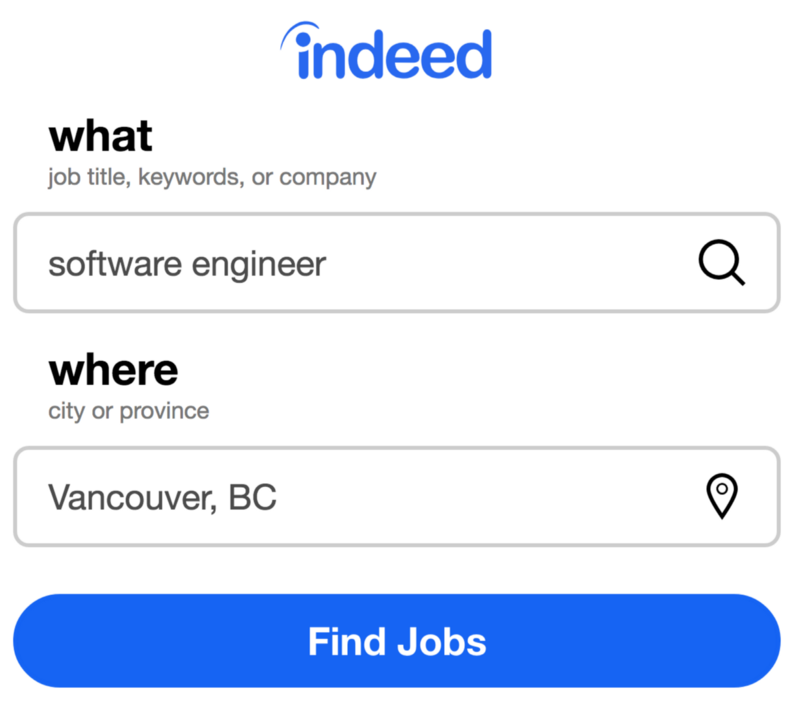
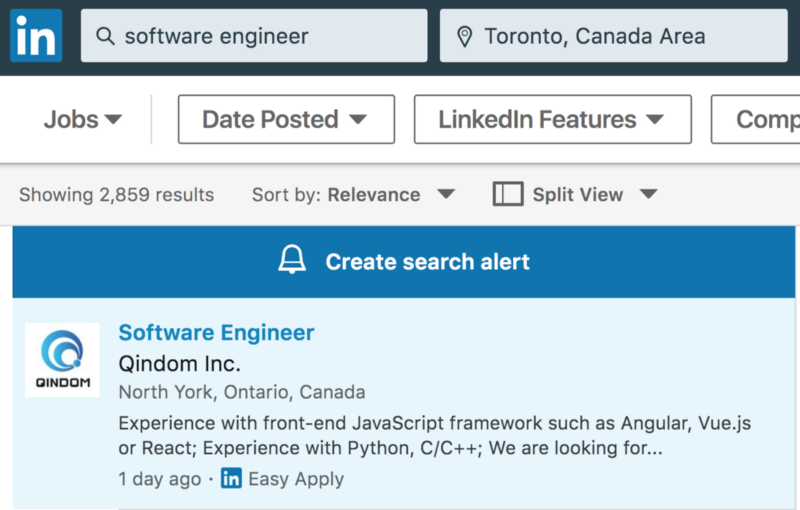
Using this strategy, suppose you’ve found at least one job opening that you’re interested in.
Let’s say you’re interested in this software engineer job at Palantir.
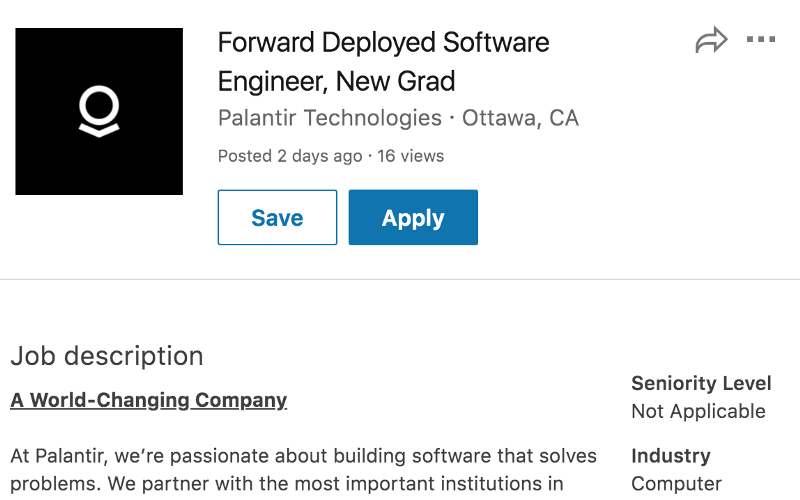
Step 2: Find recruiters
Then, instead of simply applying online, I would first find recruiters at this company. You can do this fairly easily on LinkedIn. Just search for keywords like “recruiter <company name>”.
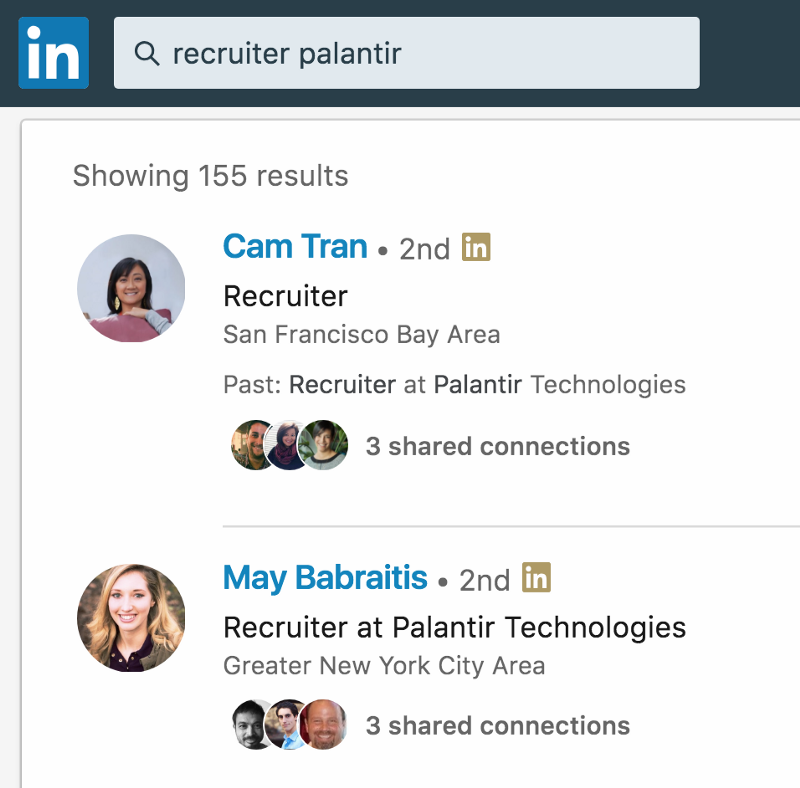
Ideally, you should be able to find 6–10 recruiters from this company.
If the company is tiny (<10 people or so), you might want to target non-recruiters as well. Try engineers, the CTO, and even the CEO if you’re applying to a tiny company.
Step 3: Add the recruiters on LinkedIn
The next step is to either send connection requests to the recruiters you’ve found on LinkedIn, or message them there.
Adding them is easier, and it’s free. However, LinkedIn might stop you from adding people if you add too many people in a short period of time. At that point, you might need to switch to LinkedIn messaging, which might cost a little bit of money.
Anyway, once you find 6–10 recruiters from the company you’re interested in, I would just send all of them connection requests at the same time. I wouldn’t add any custom message here to make this process as easy as possible.
If you send 6–10 connection requests, about 2–5 of them should accept your requests within a week or so.
Step 4: Send a custom message
After the previous step, suppose 2–5 people accepted your connection requests. This is a good sign, because this means that they use LinkedIn at least somewhat actively.
Then, send them a message like the following:
Hi <first name>,
Thank you for accepting my connection request.
I’m thinking of applying to this position I found on your website: <URL>
I’m about to graduate from a 6-month coding bootcamp program that covers full-stack development in JavaScript.
I was wondering, would I be qualified enough for this position? If not, is there anything I can do to better prepare myself?
Regards,
<your first name>
In this example message, you are asking about the following two points:
- Am I qualified for this position?
- If I’m not qualified yet, what should I do?
By asking these questions, you’ll have a better idea about where you stand in the job market, as well as what you can do to improve your position.
At the same time, this is a good way to start building connections with key people in the industry.
Of course, customize this message so that it better fits your particular situation and your voice.
Step 5: Send a follow-up message
Once you send this message to the 2–5 people who added you back on LinkedIn, you should be able to receive 1–2 replies.
If they say you’re qualified enough, then it’s great. Apply for this position online. Then, if you don’t hear back from them in two weeks, send them a message like this:
Hi <first name>,
As you suggested, I applied to the <position name> position about two weeks ago.
I was just wondering what the status of my application might be?
Regards,
<your first name>
After the initial message, if they say you’re not qualified, that’s fine, too. Ask them what you can do to better prepare yourself if you haven’t yet. Then, if you’d like, follow their recommendation to increase your chances next time.
If you follow their recommendation, you can message them in a few months again and let them know about the progress you’ve made. Then, ask them again if you’re qualified enough.
After all of these steps, chances are, you’ll be able to start getting job interviews. If not, at least you should be able to start building meaningful connections and get better ideas about what skills to work on.
Recap
Here’s my 5-step strategy for getting a job interview through LinkedIn.
- Step 1: Find a job opening
- Step 2: Find recruiters
- Step 3: Add the recruiters on LinkedIn
- Step 4: Send a custom message
- Step 5: Send a follow-up message
I like to think of these steps like a sales funnel. You start with 6–10 recruiters at each company. Then, only 2–5 of them will accept your connection requests. Out of those people, only 0–2 of them will reply to your message.
Note that you can follow this strategy for multiple companies at the same time.
So, for Step 1 (find a job opening), you should find 5–6 positions at the same time. If you follow the rest of the steps simultaneously for all 5–6 positions, you should be able to get at least one good lead.
Then, just repeat Step 1 (find a job opening) through Step 5 (a follow-up message). Meanwhile, keep increasing your programming skills by building interesting projects on the side.
2. In-person networking
In-person networking is also very effective for getting a job, particularly for small to medium-sized companies.
For this, use your interests as a guide.
For example, let’s say you like iOS development. Then, look for iOS-related events near you on services like Meetup.com and Facebook Events.
You can just search for terms like iOS, mobile development, and React Native on those sites.
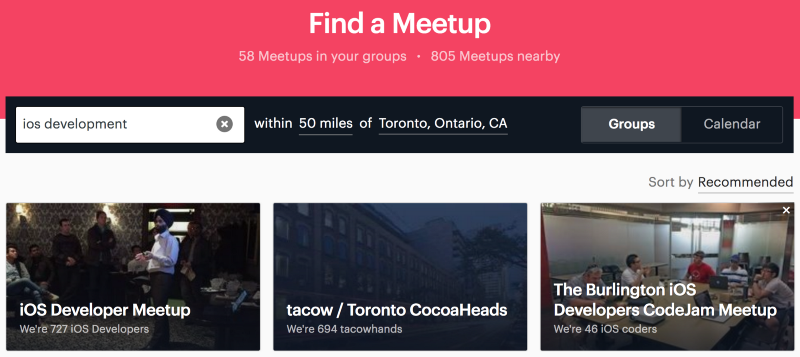
Then, go to one of the events near you.
Once you’re at one of the events, your focus should be learning as much as possible. If there’s a presentation there, see if you can learn anything from it. If there are people in the industry there, see if you can learn anything from them.
Also, make sure to talk to people individually. If you are not sure what to say at one of these events, you can use something like the following:
First, wave at someone who’s not talking to anyone else to get their attention. Then, say:
Hi! How are you?
- Good, how are you?
Good. So, what’s your name? OR — So, what brings you here?
Then, use your curiosity as a guide for making conversation. If you don’t feel comfortable with the person you started talking to, just find someone else.
At some point, they’ll probably ask you something like, “What brings you here?”
At that point, you can explain that you’re there to learn more about the industry/technology, and that you’re also looking for a job.
If they know about local opportunities, chances are, they’ll tell you about it.
My piece of advice here is to not just ask for help, but also to offer help when you can. For example, volunteering for local organizations is a great way to get to know people in the industry in your area.
3. Getting referrals
Getting referred by your friends is also a great way to land job interviews, whether you’re applying to small companies or large companies.
If you have friends who work at one of the companies you want to work at, that’s great. See if they can refer you there.
If not, there’s still a chance to use this strategy.
There’s an interesting story about this in Rejection Proof, a book about overcoming the fear of being rejected.
In it, the author’s wife tries different strategies to get a job at Google.
One of the most effective strategies she tries is using LinkedIn to build connections. Through LinkedIn, she asks for help from a number of people who work at Google. Some of them are so impressed by her initiative, they end up referring her to the company. Eventually, that’s how she gets the job.
Now, if you feel like you’re up for it, I’d suggest that you try the same strategy.
First, find key people in your industry — for example, software engineers at companies you want to work for.
Then, use a similar strategy as the one I mentioned earlier in the LinkedIn section. First, add them on LinkedIn. Then, send custom messages to the people who add you back.
You might want to send them a message like this:
Hi <first name>,
Thank you for accepting my connection request.
I’m in the process of preparing myself for a software engineer position at <company name>.
I feel like you’ve been in a similar position as myself since you also went to a JavaScript-based coding bootcamp.
Could you maybe tell me a little bit about how you prepared yourself for your position after graduating?
Please don’t worry about replying if you’re busy. Either way, thank you for reading this message!
Regards,
<your first name>
A few things to note here:
- If you are targeting a large, popular company, I would contact non-recruiters. Recruiters at large popular companies usually don’t reply, probably just because they get too many messages on LinkedIn.
- In my message above, there’s quite a bit of customization — for example, “I saw that you also went to a JavaScript-based coding bootcamp.” This will let them feel like you care about them, too.
- You should ask a specific question instead of just asking them to “pick their brain.”
- At the end of a message like this, I like saying something like, “Please don’t worry about responding if you’re busy.” This will make them feel more at ease about this message. This is especially important if you’re contacting non-recruiters, since replying to your message is not part of their job.
Once you make the initial contact that way, ask for one more piece of advice. Thank them for their advice, follow it, and follow up again in a few months.
Then, show the progress you’ve made based on their advice. Eventually, if you feel like you’ve made a solid enough connection, ask for a referral.
4. Career fairs / recruiting events
Using career fairs / recruiting events at universities near you is also an effective strategy, both for small and large companies.
Even if you don’t currently go to a university, you can still attend one of these. Sometimes they’re held at public places.
Also, if you find one that’s held at a university where you’re not a student, you can still try going.
Often times, these events don’t check for student ID’s. So, just try going to the event, and talk to the companies there. Then, explain to them that you’re not a student but that you’re still looking for a job.
If you’re new to these events, you might not be sure what to say exactly. If that’s the case, here’s a script you can use:
Hi! Do you have any open positions for entry-level software engineers?
- Yes. We have this and this positions.
Hmm, I would like to apply for this position, but I’m not sure if I’m qualified enough... Could you maybe take a look at my resume?
- Sure. Okay, I think you might be qualified. Let me pass this to our recruiter.
Thank you. Do you have any advice on how to better prepare myself for this position, based on my current skill level?
If you don’t know anything about the company you want to talk to, you can just say the following at the beginning:
Hi! I was just wondering, could you explain what your company does?
- Hi, our company does X and Y.
Your goal at one of these events should be to give out at least 7–15 copies of your resume. Bring 20 copies just to be safe.
Then, talk to one company after another without spending too much time on any one of them. If you give copies of your resume to 15 companies, you should be able to get at least 2–3 interviews as long as you have a solid programming foundation.
By the way, if you need some advice on how to prepare your resume, I have an article about it here.
Recap
Now, let’s quickly review what we discussed in this article.
The four best ways to apply for software engineer jobs are:
- Using LinkedIn
- In-person networking
- Getting referrals
- Career fairs / recruiting events
If you’re applying to small to medium-sized companies, focus on LinkedIn and in-person networking.
If you’re applying to larger, more popular companies, focus on getting referrals and using recruiting events on top of simply applying online.
Use all four strategies, and focus on what works the best for you.
Additional resources:
- My article on preparing your software engineer resume
- How to get a software engineer job at a top tech company
Okay, good luck, and thank you as always for reading my article!
If you have any questions about this or anything else, please feel free to let me know in a comment below or on Instagram or Twitter (@ykdojo on both).
